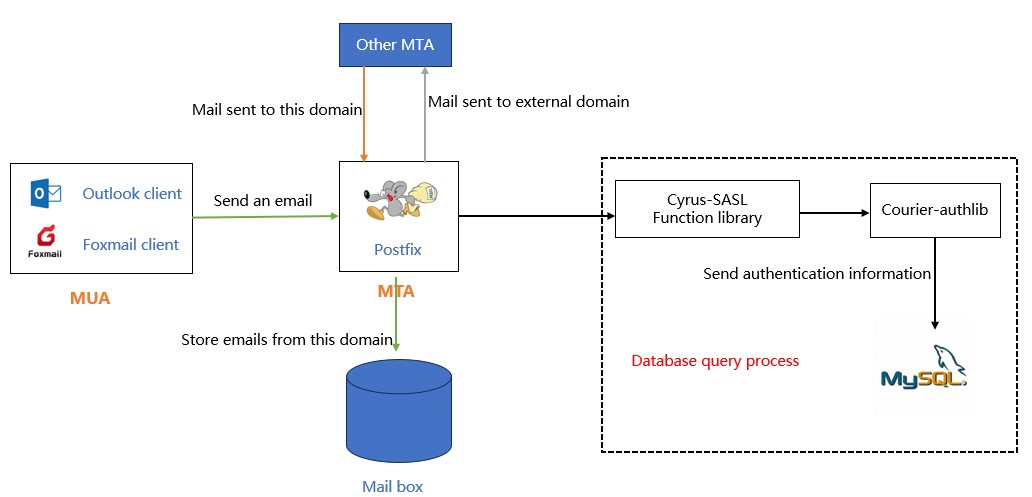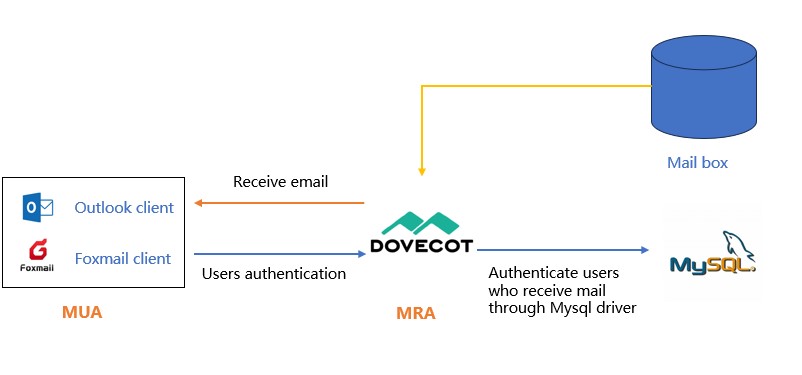Overview of email system¶
Email, as one of the three major services (FTP, Web, and email) at the beginning of the internet, is still used by many people today. Email first appeared in the 1960s, and email based on network transmission first appeared in 1971.
Unlike commercial companies' email systems, the email system's open source version consists of many parts. It is not a single service, leading to more complex email systems in GNU/Linux environments.
The basic concept of email system¶
The email system mainly consists of four parts: MUA, MTA, MRA and MDA.
- MUA (Mail User Agent): That is mail clients for users, such as Outlook, Foxmail, etc.
- MTA (Mail Transfer Agent): Refers to an email server program that is used to transmit mail. The MTA is the implementation of SMTP.
- MDA (Mail Delivery Agent): When the MTA receives the mail, the MDA is responsible for saving the email to the designated location on the email server, while also performing email filtering and antivirus operations.
- MRA (Mail Retrieval Agent): The MRA is an implementation of IMAP and POP3, used to interact with MUA and transmit emails to email clients through IMAP or POP3.
Three protocols¶
- SMTP (Simple Mail Transfer Protocol): The standard protocol for sending emails, with a default port of "TCP 25". Use the "TCP 465" port when an encryption function is required.
- IMAP (Internet Mail Access Protocol): Used to receive emails from the email server, the default port is 143. Use the 993 port when an encryption function is required.
- POP3 (Post Office Protocol - Version 3): Used to receive emails from the email server, the default port is 110. Use the 995 port when an encryption function is required.
The difference between IMAP and POP3 is as follows:
| Operating position | Operation content | IMAP | POP3 |
|---|---|---|---|
| Inbox | Reading, tagging, moving, deleting emails, etc. | Client synchronizes with mailbox updates | Within the client only |
| Outbox | Save to Sent Mail | Client synchronizes with mailbox updates | Within the client only |
| create folder | Create a new custom folder | Client synchronizes with mailbox updates | Within the client only |
| draft | Save Draft Email | Client synchronizes with mailbox updates | Within the client only |
| Junk folder | Received emails that were mistakenly moved to the junk folder | support | not supported |
| Advertising email | Receive messages that have been moved to the ad mail folder | support | not supported |
Concrete realization¶
As shown in the picture below, this is a simple illustration of the sending and receiving of an email system.

- MTA: In GNU/Linux, the mainstream and common MTA are postfix,qmail, sendmail.
- MDA: In GNU/Linux, the mainstream and common MDA are procmail and maildrop.
- MRA: In GNU/Linux, the mainstream and common MDA are dovecot.
Question
Why is DNS required to participate in the work of the email system? In daily use, the standard format for an email user is "username@domain name". A domain name cannot represent a specific host, you need to point the domain name to a specific host name, so we need a DNS MX resolution record.
Postfix The process of sending and receiving emails¶
Sendmail was born in 1983 and was installed by default in versions prior to CentOS6. Due to some historical reasons (such as complex configuration files), the development of sendmail has been hindered. Although sendmail is complex, if you have strong technical skills or extensive experience, a well-tuned sendmail is excellent in terms of efficiency and performance.
Postfix was created in 1990 by Wietse Venema, a Dutch researcher at IBM, to improve the sendmail mail server.

For more information about postfix, please refer to these two links:
The process of sending emails by the client¶

Postfix determines whether an email sent from a client belongs to the local or external domain. The email will be stored in the local domain mailbox if it belongs to the local domain. If the email sent belongs to an external domain, it is forwarded to another MTA (the user's identity needs to be verified from the database before forwarding).
The process of receiving emails by the client¶

Open source email server¶
A complete email system consists of components that are decentralized and maintained by different individuals or organizations, and the barriers to use for some people are high. As a result, some open source email servers emerge as the times require, these email servers combine these components to make an out-of-the-box product, for users, all aspects are relatively simple and easy.
Author: tianci li